1990 MITSUBISHI SPYDER service
[x] Cancel search: servicePage 1170 of 2103
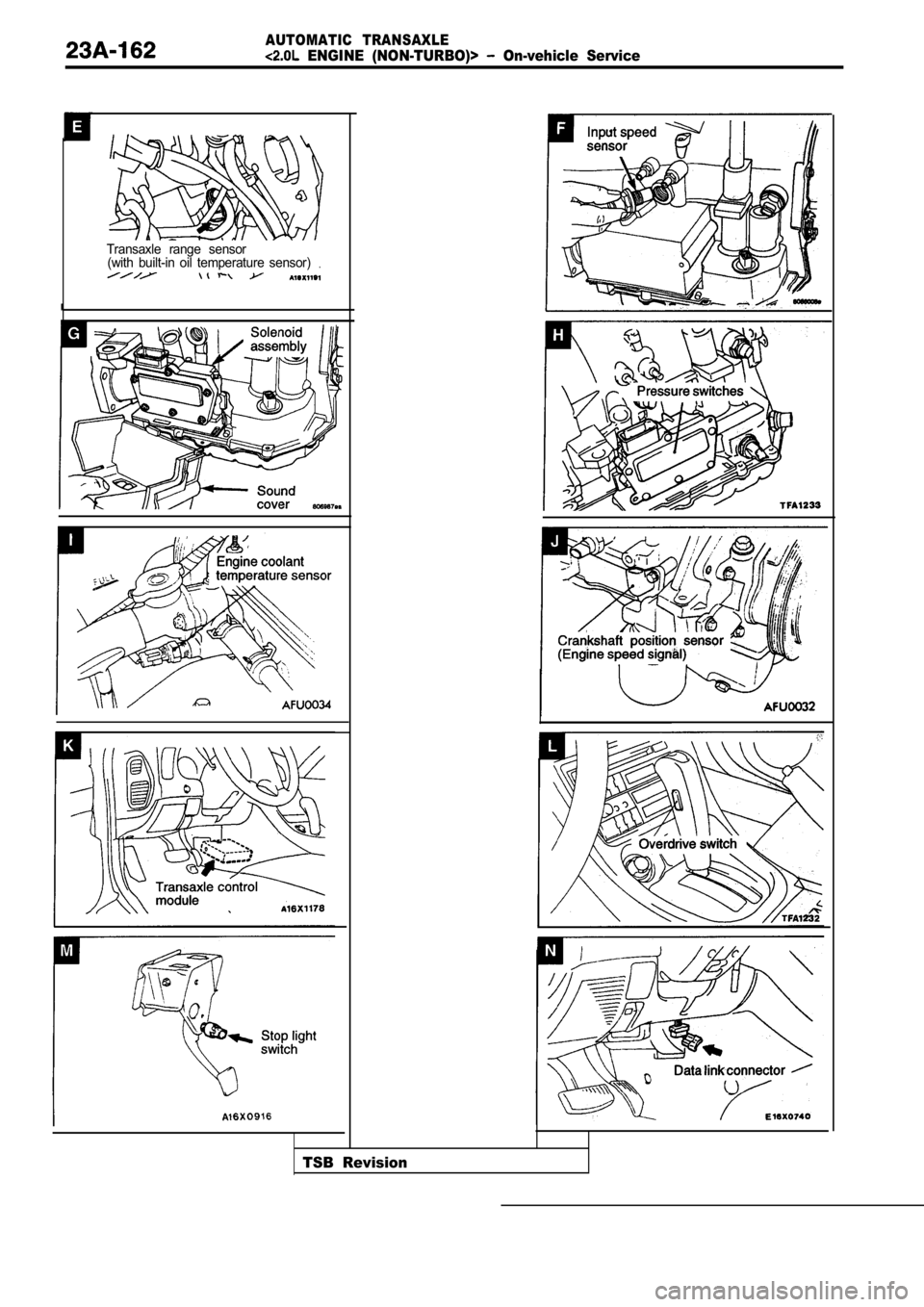
AUTOMATIC TRANSAXLE
ENGINE (NON-TURBO)> On-vehicle Service
Transaxle range sensor.(with built-in oil temperature sensor)
TSB Revision
Page 1172 of 2103
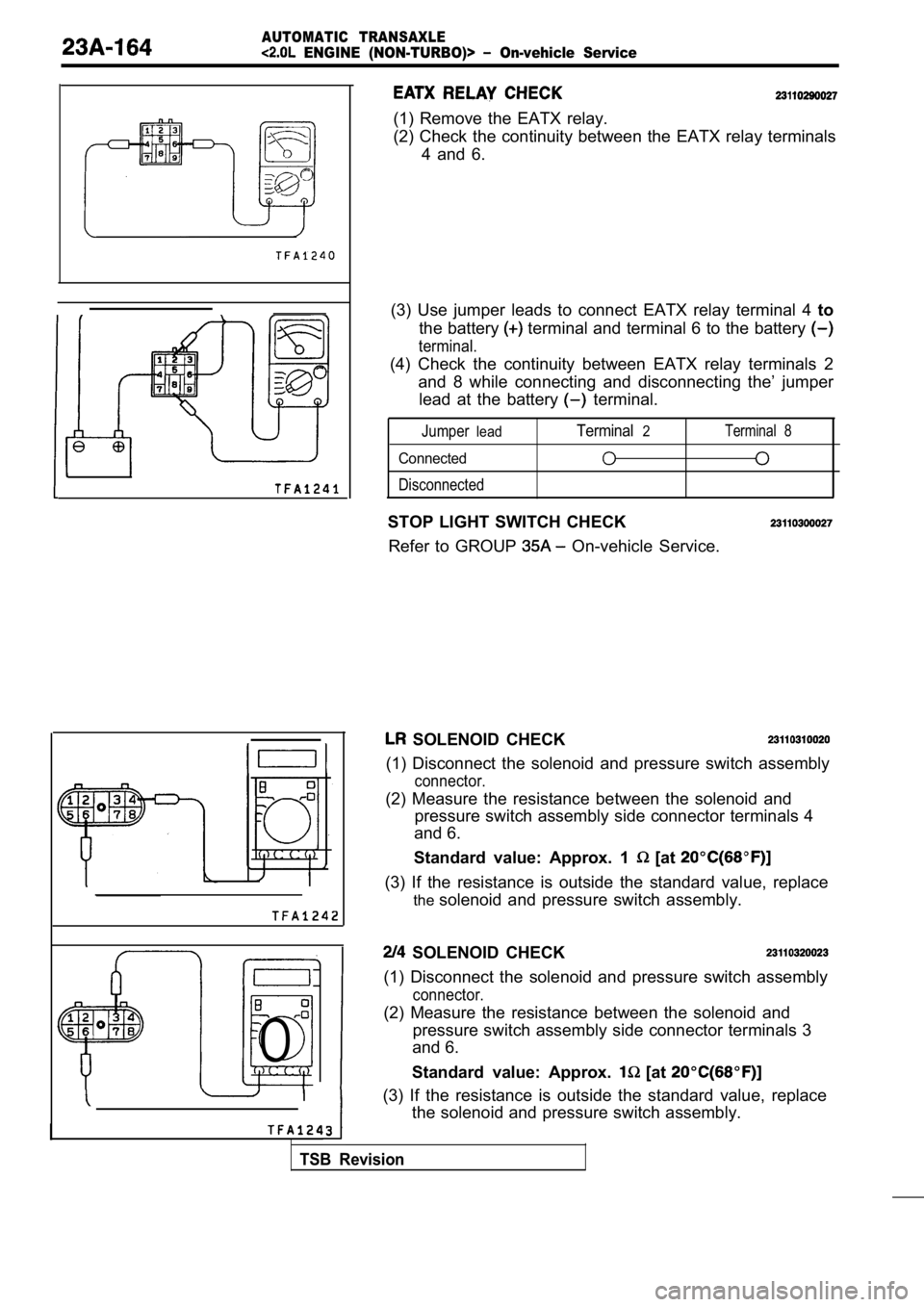
AUTOMATIC TRANSAXLE
ENGINE (NON-TURBO)> On-vehicle Service
0
I
(1) Remove the EATX relay.
(2) Check the continuity between the EATX relay terminals
4 and 6.
(3) Use jumper leads to connect EATX relay terminal 4 to
the battery
terminal and terminal 6 to the battery
terminal.
(4) Check the continuity between EATX relay termina ls 2
and 8 while connecting and disconnecting the’ jumpe r
lead at the battery
terminal.
Jumperlead
Connected
Disconnected
Terminal2Terminal 8
STOP LIGHT SWITCH CHECK
Refer to GROUP
On-vehicle Service.
SOLENOID CHECK
(1) Disconnect the solenoid and pressure switch ass embly
connector.
(2) Measure the resistance between the solenoid and
pressure switch assembly side connector terminals 4
and 6.
Standard value: Approx. 1
[at
(3) If the resistance is outside the standard value , replace
the solenoid and pressure switch assembly.
SOLENOID CHECK
(1) Disconnect the solenoid and pressure switch ass embly
connector.
(2) Measure the resistance between the solenoid and
pressure switch assembly side connector terminals 3
and 6.
Standard value: Approx.
[at
(3) If the resistance is outside the standard value , replace
the solenoid and pressure switch assembly.
TSB Revision
Page 1174 of 2103
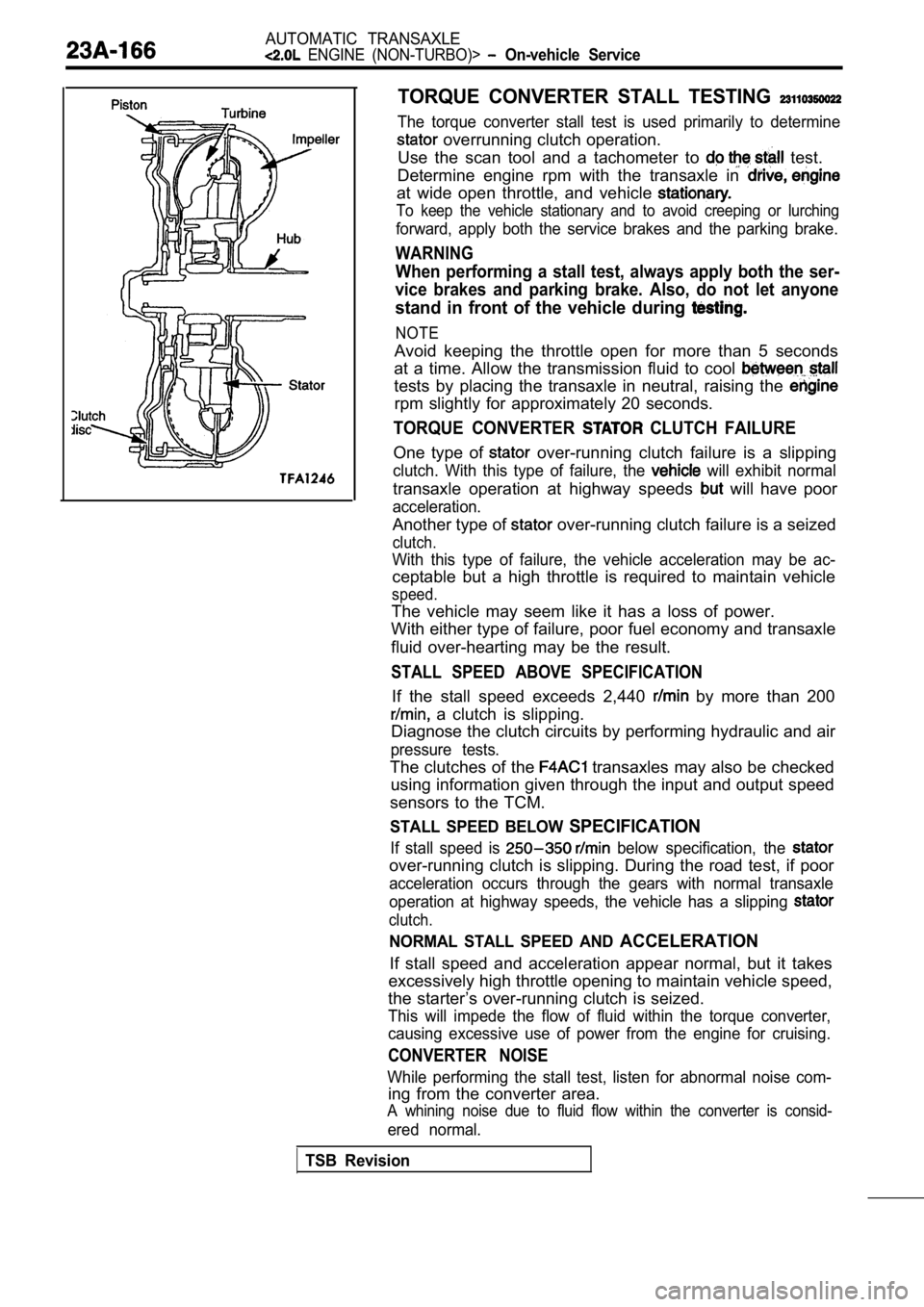
AUTOMATIC TRANSAXLE
ENGINE (NON-TURBO)> On-vehicle Service
TORQUE CONVERTER STALL TESTING
The torque converter stall test is used primarily to determine
overrunning clutch operation.
Use the scan tool and a tachometer to
test.
Determine engine rpm with the transaxle in
at wide open throttle, and vehicle
To keep the vehicle stationary and to avoid creepin g or lurching
forward, apply both the service brakes and the parking brake.
WARNING
When performing a stall test, always apply both the ser-
vice brakes and parking brake. Also, do not let any one
stand in front of the vehicle during
NOTE
Avoid keeping the throttle open for more than 5 seconds
at a time. Allow the transmission fluid to cool
tests by placing the transaxle in neutral, raising the
rpm slightly for approximately 20 seconds.
TORQUE CONVERTER CLUTCH FAILURE
One type of over-running clutch failure is a slipping
clutch. With this type of failure, the will exhibit normal
transaxle operation at highway speeds will have poor
acceleration.
Another type of over-running clutch failure is a seized
clutch.
With this type of failure, the vehicle acceleration may be ac-
ceptable but a high throttle is required to maintai n vehicle
speed.
The vehicle may seem like it has a loss of power.
With either type of failure, poor fuel economy and transaxle
fluid over-hearting may be the result.
STALL SPEED ABOVE SPECIFICATION
If the stall speed exceeds 2,440 by more than 200
a clutch is slipping.
Diagnose the clutch circuits by performing hydrauli c and air
pressure tests.
The clutches of the transaxles may also be checked
using information given through the input and outpu t speed
sensors to the TCM.
STALL SPEED BELOW SPECIFICATION
If stall speed is below specification, the
over-running clutch is slipping. During the road te st, if poor
acceleration occurs through the gears with normal t ransaxle
operation at highway speeds, the vehicle has a slip ping
clutch.
NORMAL STALL SPEED AND ACCELERATION
If stall speed and acceleration appear normal, but it takes
excessively high throttle opening to maintain vehic le speed,
the starter’s over-running clutch is seized.
This will impede the flow of fluid within the torqu e converter,
causing excessive use of power from the engine for cruising.
CONVERTER NOISE
While performing the stall test, listen for abnormal noise com-
ing from the converter area.
A whining noise due to fluid flow within the conver ter is consid-
ered normal.
TSB Revision
Page 1175 of 2103
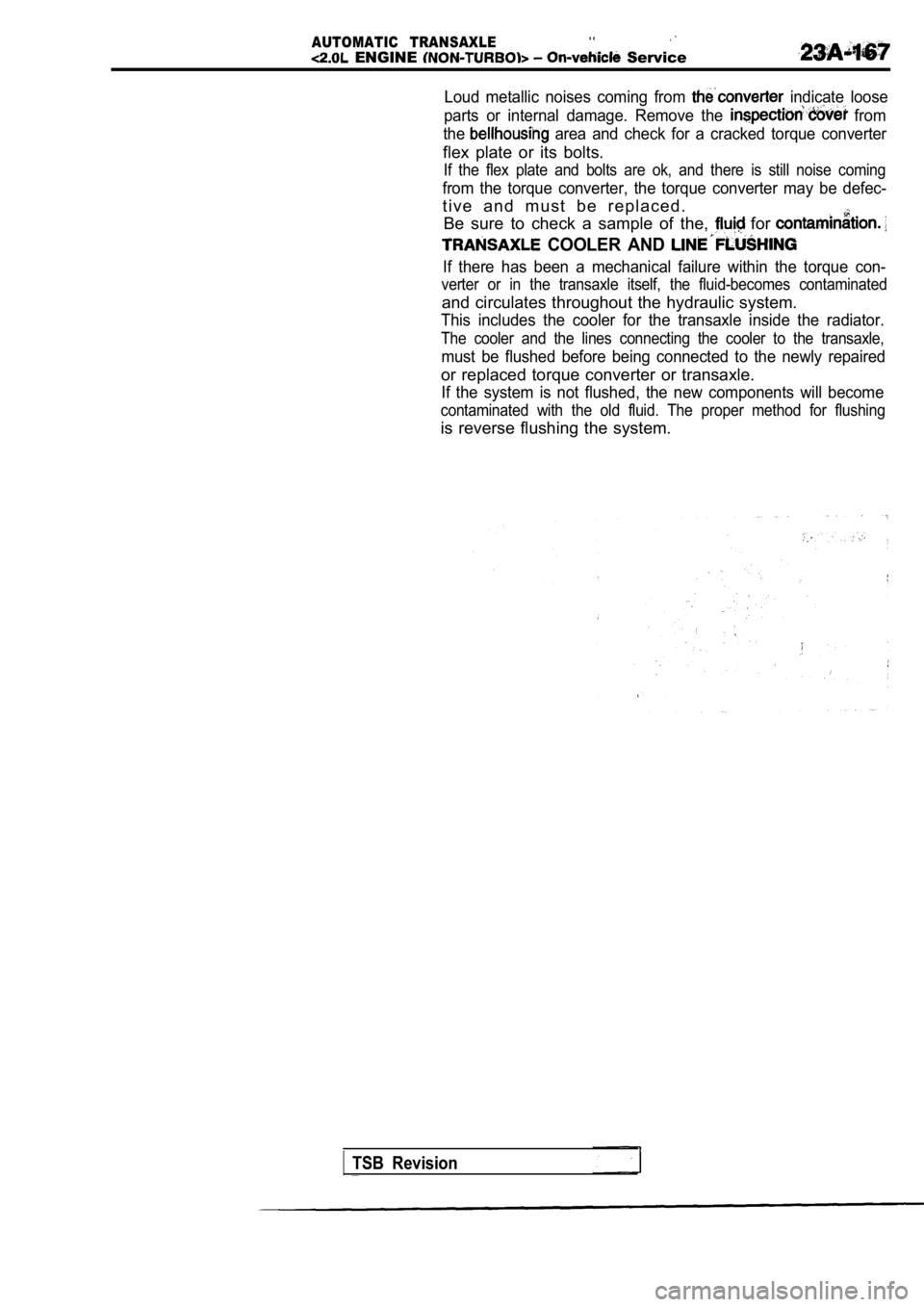
AUTOMATIC TRANSAXLE. .
ENGINE Service
Loud metallic noises coming from indicate loose
parts or internal damage. Remove the
from
the
area and check for a cracked torque converter
flex plate or its bolts.
If the flex plate and bolts are ok, and there is st ill noise coming
from the torque converter, the torque converter may be defec-
t i v e a n d m u s t b e r e p l a c e d .
Be sure to check a sample of the,
for
COOLER AND
If there has been a mechanical failure within the t orque con-
verter or in the transaxle itself, the fluid-becomes contaminated
and circulates throughout the hydraulic system.
This includes the cooler for the transaxle inside t he radiator.
The cooler and the lines connecting the cooler to t he transaxle,
must be flushed before being connected to the newly repaired
or replaced torque converter or transaxle.
If the system is not flushed, the new components will become
contaminated with the old fluid. The proper method for flushing
is reverse flushing the system.
TSB Revision
Page 1176 of 2103
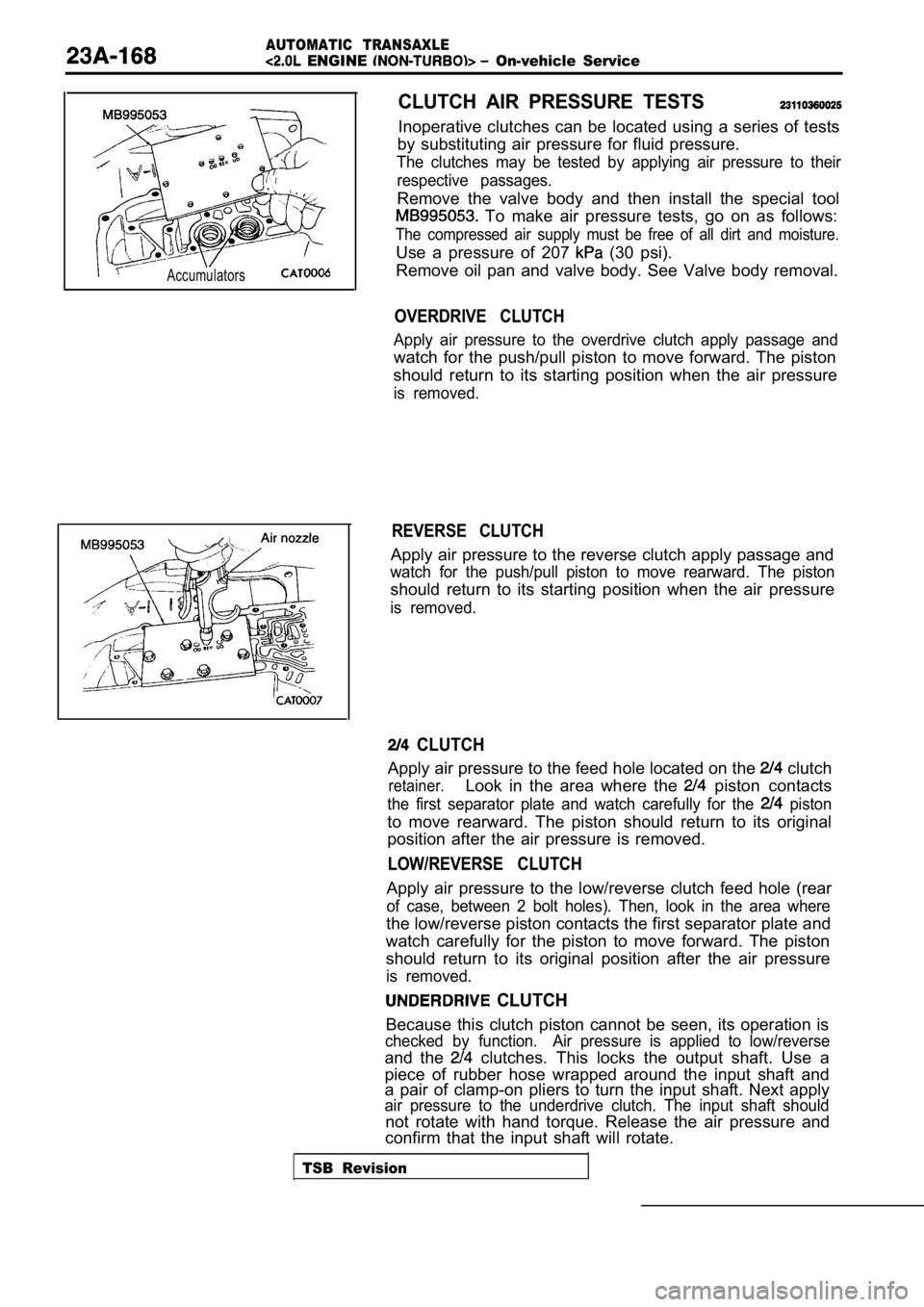
AUTOMATIC TRANSAXLE
ENGINE On-vehicle Service
Accumulators
CLUTCH AIR PRESSURE TESTS
Inoperative clutches can be located using a series of tests
by substituting air pressure for fluid pressure.
The clutches may be tested by applying air pressure to their
respective passages.
Remove the valve body and then install the special tool
To make air pressure tests, go on as follows:
The compressed air supply must be free of all dirt and moisture.
Use a pressure of 207 (30 psi).
Remove oil pan and valve body. See Valve body remov al.
OVERDRIVE CLUTCH
Apply air pressure to the overdrive clutch apply passage and
watch for the push/pull piston to move forward. The piston
should return to its starting position when the air pressure
is removed.
REVERSE CLUTCH
Apply air pressure to the reverse clutch apply pass age and
watch for the push/pull piston to move rearward. Th e piston
should return to its starting position when the air pressure
is removed.
CLUTCH
Apply air pressure to the feed hole located on the clutch
retainer.Look in the area where the piston contacts
the first separator plate and watch carefully for the piston
to move rearward. The piston should return to its o riginal
position after the air pressure is removed.
LOW/REVERSE CLUTCH
Apply air pressure to the low/reverse clutch feed h ole (rear
of case, between 2 bolt holes). Then, look in the a rea where
the low/reverse piston contacts the first separator plate and
watch carefully for the piston to move forward. The piston
should return to its original position after the ai r pressure
is removed.
CLUTCH
Because this clutch piston cannot be seen, its oper ation is
checked by function. Air pressure is applied to low/ reverse
and the clutches. This locks the output shaft. Use a
piece of rubber hose wrapped around the input shaft and
a pair of clamp-on pliers to turn the input shaft. Next apply
air pressure to the underdrive clutch. The input sh aft should
not rotate with hand torque. Release the air pressu re and
confirm that the input shaft will rotate.
TSB Revision
Page 1178 of 2103
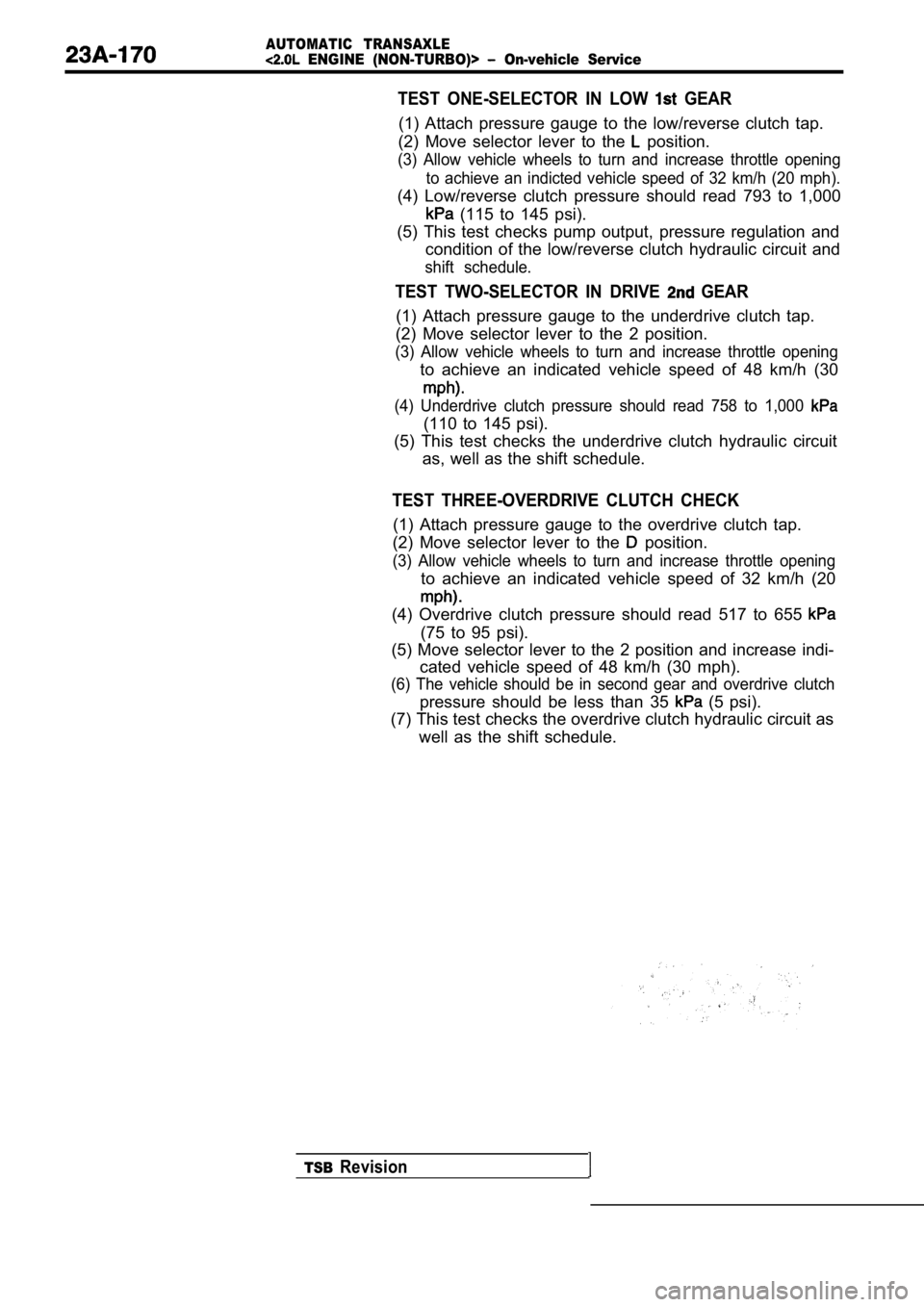
AUTOMATIC TRANSAXLE ENGINE (NON-TURBO)> On-vehicle Service
TSB
Revision
TEST ONE-SELECTOR IN LOW GEAR
(1) Attach pressure gauge to the low/reverse clutch tap.
(2) Move selector lever to the
position.
(3) Allow vehicle wheels to turn and increase throt tle opening
to achieve an indicted vehicle speed of 32 km/h (20 mph).
(4) Low/reverse clutch pressure should read 793 to 1,000
(115 to 145 psi).
(5) This test checks pump output, pressure regulati on and
condition of the low/reverse clutch hydraulic circu it and
shift schedule.
TEST TWO-SELECTOR IN DRIVE GEAR
(1) Attach pressure gauge to the underdrive clutch tap.
(2) Move selector lever to the 2 position.
(3) Allow vehicle wheels to turn and increase throt tle opening
to achieve an indicated vehicle speed of 48 km/h (3 0
(4) Underdrive clutch pressure should read 758 to 1,000
(110 to 145 psi).
(5) This test checks the underdrive clutch hydrauli c circuit
as, well as the shift schedule.
TEST THREE-OVERDRIVE CLUTCH CHECK
(1) Attach pressure gauge to the overdrive clutch t ap.
(2) Move selector lever to the
position.
(3) Allow vehicle wheels to turn and increase throt tle opening
to achieve an indicated vehicle speed of 32 km/h (2 0
(4) Overdrive clutch pressure should read 517 to 655
(75 to 95 psi).
(5) Move selector lever to the 2 position and incre ase indi-
cated vehicle speed of 48 km/h (30 mph).
(6) The vehicle should be in second gear and overdr ive clutch
pressure should be less than 35 (5 psi).
(7) This test checks the overdrive clutch hydraulic circuit as
well as the shift schedule.
Page 1179 of 2103

AUTOMATIC TRANSAXLE
On-vehicle Service
TEST FOUR-SELECTOR IN
(1) Attach pressure to tap.,,;
(2) Move selector lever to the position,
(3) Allow vehicle wheels to turn and increase,
to achieve an indicated vehicle speed of
“mph).
(4) The clutch pressure should read 517 to
(75 to 95 psi).
(5) This test checks the clutch hydraulic circuit.
IN
(1) Attach pressure gauge to the torque
off pressure tap.
(2) Move selector lever to the position.’
(3) Allow vehicle wheels to turn and increase
to achieve an indicated vehicle speed of 80 km/h
m p h ) .
CAUTION
must turn at the ‘speed.
(4)
(5)Torque converter clutch off pressure should be
35 (5 psi).
This test checks the torque converter clutch
circuit.
. ,
TEST SIX-SELECTOR IN REVERSE
(1) Attach pressure gauge to the reverse clutch tap .
(2) Move selector lever to the reverse position.
(3) Read reverse clutch pressure with output statio nary (foot
on brake) and throttle opened to achieve 1,500
(4) Reverse clutch pressure should read 1,138 to 1, 620
(165 to 235 psi).
(5) This test checks the reverse clutch hydraulic c ircuit.
TEST RESULT INDICATIONS
(1) If proper line pressure is found in any one test, the pump
and pressure regulator are working properly.
(2) Low pressure in all positions indicates a defec tive pump,
a clogged filter, or a stuck pressure regulator valve.
(3) Clutch circuit leaks are indicated if pressures do not fall
within the specified pressure range.
(4) If the overdrive clutch pressure is greater tha n 35
(5 psi) in step (6) of Test Three, a worn reaction shaft
seal ring is indicated.
TSB Revision
Page 1180 of 2103
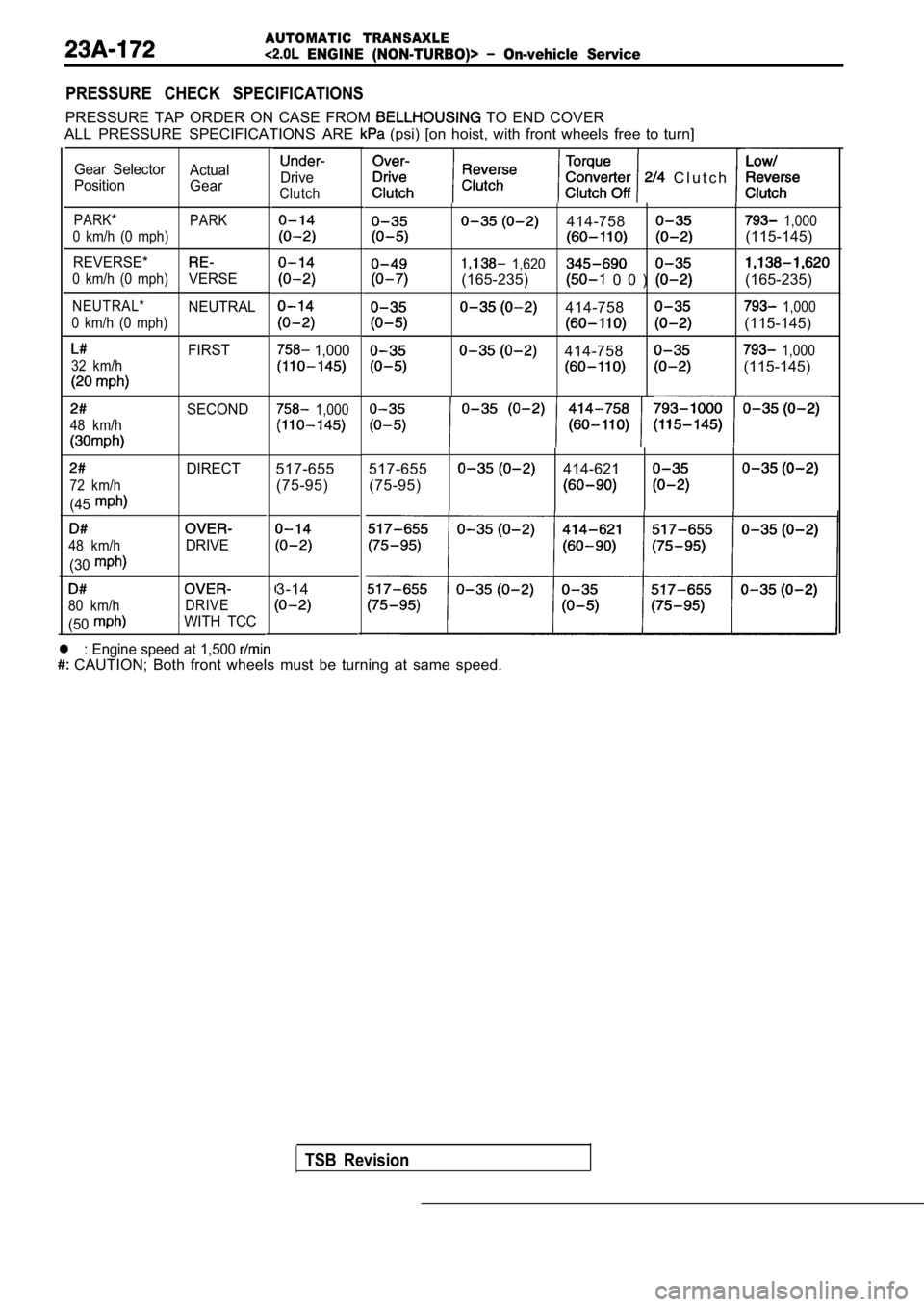
AUTOMATIC TRANSAXLE
ENGINE (NON-TURBO)> On-vehicle Service
PRESSURE CHECK SPECIFICATIONS
PRESSURE TAP ORDER ON CASE FROM TO END COVER
ALL PRESSURE SPECIFICATIONS ARE
(psi) [on hoist, with front wheels free to turn]
Gear Selector Actual
Position Gear
PARK* PARK
0 km/h (0 mph)
REVERSE*
0 km/h (0 mph)VERSE
NEUTRAL*NEUTRAL
0 km/h (0 mph)
FIRST
32 km/h
48 km/h
SECOND
72 km/h
(45
DIRECT
48 km/h
(30
DRIVE
80 km/h
(50
DRIVE
WITH TCC
Drive
Clutch
1,000
C l u t c h
414-758 1,000
(115-145)
1,620
(165-235) 0 0 ) (165-235)
414-758 1,000
(115-145)
414-758 1,000
(115-145)
1,000
517-655 517-655414-621
(75-95) (75-95)
3-14
l : Engine speed at 1,500
CAUTION; Both front wheels must be turning at same speed.
TSB Revision